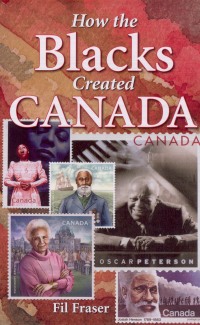| ________________
CM . . .
. Volume XVII Number 5. . . .October 1, 2010 
 |
How the Blacks Created Canada.
Fil Fraser.
Edmonton, AB: Dragon Hill (Distributed by Lone Pine Publishing), 2009.
255 pp., pbk., $18.95.
ISBN 978-1-896124-43-8.
Subject Headings:
Blacks-Canada-History.
Black Canadians-History.
Grades 11 and up / Ages 16 and up.
Review by Joanne Peters.
*** /4
|
| |
|

excerpt:
Across geography and time, Blacks have played pivotal roles in the creation of Canada.
But while their achievements are gradually being chronicled in a developing library both of popular and scholarly works, with rare exceptions, that history has been virtually invisible to mainstream Canadians. Black immigrants and refugees from the United States, from the Caribbean and from Africa, like those from many other parts of the world, have endured a soul-sapping storm of prejudice and discrimination. But in the age of Obama, as Blacks . . .begin to emerge as fully integrated citizens, it's time for all Canadians to know who they are. It's time to celebrate the contributions and achievements of those whose roots in our soil are as deep as anyone else's.
In fact, those roots, referred to in the excerpt above, were planted by Mathieu Da Costa, a multi-talented and "multi-lingual explorer, navigator, interpreter and guide" who worked in the latter roles for Samuel de Champlain. However, the first substantial Black community in Canada resulted from a migration of nearly 3 ,000 blacks who left New York and arrived in Nova Scotia with the United Empire Loyalists in 1783. Their names are listed in the "Book of Negroes;" centuries later, a novel by that title, written by Lawrence Hill, offers a fictional account of the life of a former slave who was a member of that Black Loyalist community. Up to and including the time of the American Civil War, other former slaves settled in southern Ontario, the northern terminus of the Underground Railway to Canada, of which the town of Buxton, close to present day Chatham, was a major terminus. However, during the nineteenth century, American Blacks interested in settling the western Canada were met with less-than-friendly response. Those who did move to the Prairies "tended to establish their settlements away from white communities, preferring to avoid confrontation and discrimination." And, in British Columbia, Governor James Douglas, himself the son of a Black mother and a Scotsman, encouraged Blacks in California to head north, where they formed a substantial community in Victoria.
Following a geographic overview of early Black settlement and history in Canada, and highlighting individuals who were trail-blazers and leaders in their pioneering communities, Fraser devotes a chapter to the pivotal role played by the strength of the church. While it is certainly true that "not all Blacks are religious," in general, the church has played a pivotal role, both as a social and cultural institution, and certainly, the fundamental tenets of Christianity have been a source of solace, community, and hope.
After detailing the notable contributions of the Black community of Nova Scotia, the changes in Canadian immigration laws which led to "the Caribbean invasion," and more recently, the small but steady stream of immigrants from Africa, Fraser provides an overview of Black Canadians the "icons and trail-blazers: movers and shakers in the 21st century", both those well-known nationally and internationally (Governor-General Michaelle Jean, opera star Measha Brueggergosman) and those who are well-known primarily within the Canadian Black community.
Certainly, it is a challenge to distill centuries of history into a comparatively short work which will be accessible to the "mainstream Canadians who are the primary target audience for this book." It is always hard to select those whose stories will be highlighted, knowing well that there are undoubtedly others who are worthy of note. As a journalist, Fraser is keenly aware of the challenge he faced in his writing of the book. Suitable for high school and public library collections, How the Blacks Created Canada will be a useful resource especially for those Canadian history assignments about immigrant groups in Canada. And, it will also be particularly useful as a resource which provides a Canadian perspective on Black History – much of what is available for high school students is overwhelmingly American in focus.
How the Blacks Created Canada would have benefitted from an index. If you are looking for information on a specific individual (for example, Rosemary Brown), the only way you'll find it is by paging through the book and looking for a heading. This is not an efficient way to search and can be downright frustrating for student researchers; the publishers of the book have other titles detailing the contributions both of the French and English Canadian communities, and, if planning similar titles for other ethnic groups, an index should be considered.
However, How the Blacks Created Canada tells an important story, and it is worth acquisition by both public and high school libraries.
Recommended.
Living in Winnipeg, MB, Joanne Peters is a recently retired teacher-librarian.

To comment
on this title or this review, send mail to cm@umanitoba.ca.
Copyright © the Manitoba Library Association. Reproduction for personal
use is permitted only if this copyright notice is maintained. Any
other reproduction is prohibited without permission.
NEXT REVIEW |
TABLE OF CONTENTS FOR THIS ISSUE
- October 1, 2010.
AUTHORS |
TITLES |
MEDIA REVIEWS |
PROFILES |
BACK ISSUES |
SEARCH |
CMARCHIVE |
HOME |
